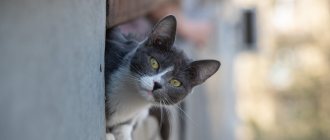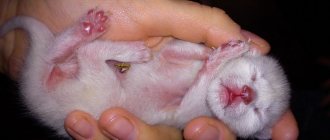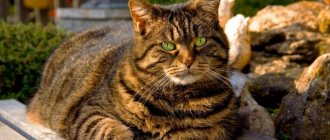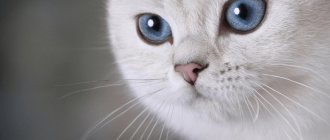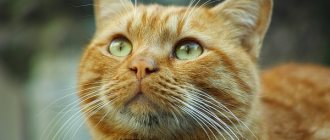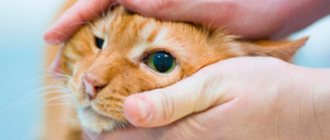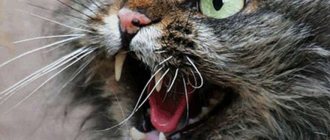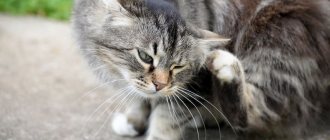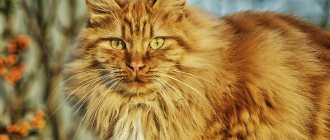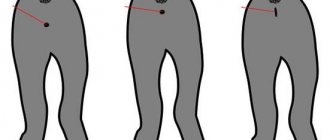Pedigree kittens have documents indicating the exact date of birth and complete information about their ancestors. But not everyone is lucky enough to be born in a good nursery and from there end up in the home of loving owners. Animals are often picked up right on the street, without knowing whether it is a teenage kitten or a mature individual. Let's find out how you can determine the age of a cat at home.
How to determine a cat's age by its teeth
An animal’s teeth are one of the surest indicators of a pet’s health and the number of years it will live. It is the condition of the teeth that will help you find out how to determine the age of the cat, and not just the baby.
Many breeders are pleased with the versatility and simplicity of this method. The jaws of all cat breeds are designed almost the same. In rare cases, serious discrepancies in dental development are observed.
The easiest way to determine the age of kittens is because their jaws are just beginning to form:
- the first incisors appear at 2-4 weeks of the baby’s life;
- milk fangs – at 3-4 weeks;
- premolars appear at 3-8 weeks;
- first molars – for 5-12 weeks;
- At 2 months, the kitten acquires a full set of 26 teeth.
Already by 3-4 months, the first teeth will begin to change to molars. It is recommended to purchase special toys for your pet that can be chewed. Permanent teeth erupt:
- incisors – by 3-5 months;
- fangs - by 4-5 months;
- premolars – at 4-6 months;
- molars - at 4-7 months.
With kids everything is quite simple. There is minor debate among felinologists about how to determine the age of a cat by its teeth. Many people advise sticking to the following “schedule”:
- by the age of one year all teeth are white and strong;
- at one and a half years a barely noticeable yellowness appears;
- 2 years – the beginning of erasing of the incisors in the center;
- 2.5-3 years – formation of the first dental stones;
- 3-4.5 years – beginning of grinding of the upper and middle incisors;
- 5 years – erasing of fangs;
- 6-8 years – beginning of wear of the rear incisors;
- by the age of 10 – the lower incisors are greatly worn down;
- 11-14 years – loss of incisors;
- 15-16 years – loss of fangs.
Important! When answering the question of how to find out the age of a cat, it is worth considering that the condition of the teeth depends on nutrition, injuries received and diseases suffered. To be sure, you can contact a veterinarian, who can examine the condition of the enamel, gums, and tartar to be sure.
Problems of transferring human standards
The question of how legitimate the ambitious desire to calculate the exact age of a cat by human standards remains open. It is important to remember that cats develop in ways that are fundamentally different from humans.
The development rates of the cat's body and the human body have little in common with each other
Yes, cats go through phases of “infancy”, “childhood”, “adolescence”, “youth” and “maturity”.
Blooming and fading are characteristic of them in the same way as other living organisms. Meanwhile, one can hardly derive any practical benefit from the assumption that Nikolai the cat is 35 cat years old. However, such methods of calculation allow the owner to “bring the animal closer” to himself and make it more understandable from a human point of view.
We should not forget that attempts to transfer the peculiarities of emotional perception, thinking and other psychological characteristics of a person to a cat are only a projection that has a distant relationship to reality.
A comprehensive ratio of cat and human ages is shown in the table below.
Cat to human age ratio
By the eyes
Eyes are not only the mirror of the soul, but also an important indicator of a pet’s age. How to find out the age of a cat at home using this criterion? It is enough to observe the behavior of the animal a little. Young cats have a lively gaze, quickly moving to an interesting object, and a little mischievous. At advanced age, these properties usually become dull.
It is worth paying attention to the structure of your pet's eyes. In a young animal, the glassy substance is smooth, without inclusions, and transparent. The iris is of even color and regular shape. In old cats, over time, the eye becomes cloudy and dull, and separation or destruction of the vitreous substance appears. The iris, which usually becomes deformed and thinner, has streaks and spots.
Important! Discharge from the eyes, clouding of the cornea, or spots on the iris may be a sign of an infectious disease or organ injury. At the first symptoms, contact your veterinarian.
Pets at a very advanced age develop wrinkles (folds) around the eyes. Discharge (watery or purulent) often forms from the lacrimal sacs.
Two to three months
As a rule, a two-month-old kitten is already able to cope with moving to a new family and getting to know a new environment. The baby can now be switched to natural products or dry food without significant harm to its health.
Vaccination
This age is largely a turning point due to the fact that it is between two and three months that the kitten undergoes its first vaccination.
Respectable breeders warn the buyer in advance whether the kitten requires any vaccinations and whether they have been given previously
Mandatory vaccinations include vaccinations against the following diseases:
- calcivirosis;
- panleukopenia (or plague);
- rhinotracheitis;
- rabies.
In addition to these diseases, the breeder can also include others at his discretion.
Vaccination schedule
As a rule, vaccination requires a certain age of the kitten and strict intervals between which the procedure must be repeated:
- the first “approach” is made at 8 weeks or two months. By this time, the kitten is strong enough to undergo vaccination without weakening. At this age, the kitten is vaccinated against all the diseases mentioned above, except for rabies;
- at four months the kitten goes through all the same vaccines again, now including rabies;
- at five months the same vaccinations are repeated as at four months.
Vaccination schedule for kittens from birth to one year
Subsequently, the pet will need to be vaccinated annually so that the body does not have time to lose the developed immunity.
Features of vaccination
A natural question may arise: “Why can’t I take the kitten to the veterinarian for vaccination and take it home?” Of course it's possible. Moreover, some owners do exactly this, buying a kitten at two months of age.
Vaccination temporarily weakens the kitten and makes it vulnerable to various diseases.
However, when taking such a step, it is necessary to be aware of the responsibility that the future owner of the animal places on his shoulders:
- firstly, there is a high probability that when moving, a kitten that has not yet been vaccinated may become infected with some disease that will be difficult for the fragile body to fight;
- secondly, the first vaccination is often not easy for a kitten. Cubs sometimes develop complications that quickly go away with the correct response from the owner. However, it can be difficult for an inexperienced person to react correctly and take the necessary actions in a timely manner.
Sometimes kittens may develop complications after vaccinations.
Of course, a two-month-old kitten will not die in your arms if you do not provide him with proper care during vaccination, but this period is very difficult for both the animal and its owner. But ultimately, assessing risks and setting your preferences is a personal matter for everyone.
Read with this
By wool
One of the solutions to the question “how to determine the age of a cat at home” is to assess the condition of the pet’s fur. However, this method is quite subjective and depends on the breed and the surrounding climate.
Young animals have a soft, uniform, silky and durable coat. With age, the coat thins and becomes dull. Old cats develop gray hairs.
Appearance
- Condition of the coat. If it is shiny and thick, the pet is young. If the coat looks unhealthy and dull, the cat is elderly. This method has inaccuracies. Cats' fur can deteriorate significantly in the presence of various diseases and helminthic infestations.
- Muscle mass. If young cats have visible muscle relief, older cats are more well-fed and round. Old cats lose weight and stoop. The skin becomes loose and flabby.
By weight
Be sure to pay attention to your pet's weight! Over the years, the animal’s daily routine changes, which is why the body weight of cats of different ages is different.
Kittens move a lot, their skeleton is not yet fully formed and strong, and the fat layer is almost not deposited. This is why babies and young pets weigh quite little.
Important! Monitor your pet's diet. A poor diet or lack of adequate exercise can lead to unhealthy weight gain!
Adults, and especially older pets, are already reluctant to agree to conquer the heights of a home closet or excitingly climb expensive curtains. They tend not to play as much and prefer to take more naps. A sedentary lifestyle leads to weight gain.
Features of the cat's life cycle
A year in the life of a cat is a long and significant period. It is equivalent to approximately four to five human years. Knowing this, it is easy to understand why cats suddenly develop arthritis, lose their vision, or stop hearing well in a fairly short period of time. A popular and erroneous method, as we wrote above, is the “seven-year” method of converting cat years into human years: one cat year is not equivalent to our seven. This is due to the fact that in the first two years the cat matures faster than in the rest. So, in the first year the cat reaches the age of 15 human years, in the second - she is already a 24-year-old person. Each subsequent year is equal to approximately 4 years of ours. After some simple calculations, we get: the age of a five-year-old cat is 36 human years (see table below). It should also be taken into account that a cat who lives on the street ages much faster, perhaps even twice as fast, than a well-groomed indoor cat.
In the first year of life, a cat reaches the age of 15 human years
By behavior
It is possible to determine the age of a pet by its behavior. This method is quite subjective and depends on the character of the animal, but there are still common features in habits.
Baby kittens spend almost all their free time playing and communicating with each other and people. They are even ready to courageously sacrifice minutes of sleep for the sake of fun! Some kids even insistently demand attention to themselves.
Important! You should not be strict with your pet's behavior. Animals also have different types of personalities, so some cats are sociable, while others are shy.
Mature pets will enjoy spending time hunting and playing. However, they tend to be very sleepy.
Older cats no longer like unnecessary fuss, preferring quiet rest to noisy games. Pets can often be found dozing peacefully on a chair or on your bed. As cats age, their hearing often becomes dull and their vision begins to decline, which can cause the animal to become a little more fearful or nervous.
By body processes
Perhaps determining age by the internal processes of the body is the most accurate way. Using this watch it is easy to find out how old your pet is.
Puberty in cats begins at 7-9 months (sometimes earlier, at 6 months), but in boys a little later - at 9-11 months. Slight differences may occur due to climate, breed and weight of the animal.
Determining the age of your pet is incredibly important. This is the only way to create the correct diet, daily routine and the amount of vitamins you need.
